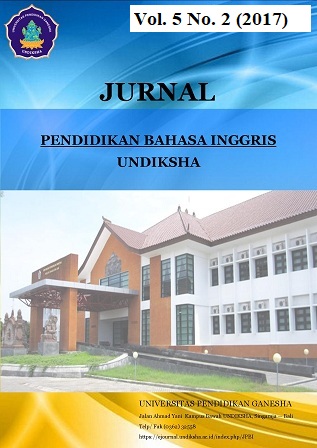CLASSROOM INTERACTION IN A BILINGUAL KINDERGARTEN: A CASE STUDY IN AURA SUKMA INSANI BILINGUAL KINDERGARTEN SINGARAJA
DOI:
https://doi.org/10.23887/jpbi.v5i2.12106Abstract
Penelitian ini bertujuan untuk menemukan kategori dari interaksi kelas yang muncuk di kelas B1 di Aura Sukma Insani Bilingual Kindergarten Singaraja berdasarkan dari Flander Interaction Analysis Categories (FIAC) System, dan interaksi yang memberi dampak pada tingkah laku siswa. Subjek dari penelitian ini adalah seorang guru dan 33 siswa di kelas B1. Penelitian ini merupakan penelitian kualitatif deskriptif. Hasil dari penelitian menunjukan: (1) semua kategori dari interaksi kelas berdasarkan Flander Interaction Analysis Categories (FIAC) System muncul dalam proses pembelajaran, meliputi: accepting feeling sebanyak 9.6%, praising or encouraging sebanyak 3.5%, accepting ideas sebanyak 0.6%, asking questions sebanyak 12.3%, lecturing sebanyak 11,3%, giving directions sebanyak 11%, criticizing or justifying authority sebanyak 2%, students’ talk response sebanyak 45,6%, students’ talk initiation sebanyak 2.2%, and silence or confusion sebanyak 1,9%. (2) Interaksi antara guru dan siswa berjalan sangat aktif dan lancar. Melalui interaksi kelas, semua siswa memperoleh hasil pembelajaran yang baik dan bertingkah laku dengan sangat baik di setiap proses belajar.Kata Kunci : Interaksi Kelas, Taman kanak-kanak dua bahasa, pelajar anak-anak, Flander Interaction Analysis Categories (FIAC) System.
This study aimed at finding the classroom interaction categories occurring in the B1 class at Aura Sukma Insani Bilingual Kindergarten Singaraja based on Flander Interaction Analysis Categories (FIAC) System, and how the interaction give impacts to the students’ achievement and behavior. The subjects of the study were one teacher and 33 students in B1 class. This study was designed by using descriptive qualitative research. The result of the research shows that: (1) all categories of classroom interaction based on Flander Interaction Analysis Categories (FIAC) System exist during teaching and learning process. Those are accepting feeling was 9.6%, praising or encouraging was 3.5%, accepting ideas was 0.6%, asking questions was 12.3%, lecturing was 11.3%, giving directions was 11%, criticizing or justifying authority was 2%, students’ talk response was 45.6%, students’ talk initiation was 2.2%, and silence or confusion was 1.9%. (2) The interaction between teacher and students run very active and smoothly. Through the classroom interaction, all of the students get good achievement and they behave very well in every meeting.
keyword : Classroom Interaction, Young Learners, Flander Interaction Analysis Categories (FIAC) System.
Published
2017-10-24
Issue
Section
Articles
License
Authors who publish with the Jurnal Pendidikan Bahasa Inggris Undiksha agree to the following terms:- Authors retain copyright and grant the journal the right of first publication with the work simultaneously licensed under a Creative Commons Attribution License (CC BY-SA 4.0) that allows others to share the work with an acknowledgment of the work's authorship and initial publication in this journal
- Authors are able to enter into separate, additional contractual arrangements for the non-exclusive distribution of the journal's published version of the work (e.g., post it to an institutional repository or publish it in a book), with an acknowledgment of its initial publication in this journal.
- Authors are permitted and encouraged to post their work online (e.g., in institutional repositories or on their website) prior to and during the submission process, as it can lead to productive exchanges, as well as earlier and greater citation of published work. (See The Effect of Open Access)













